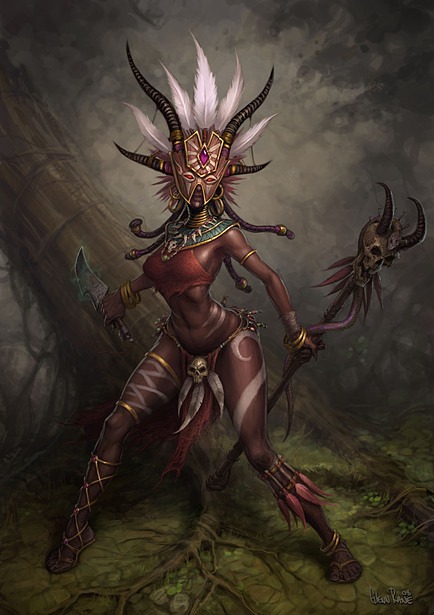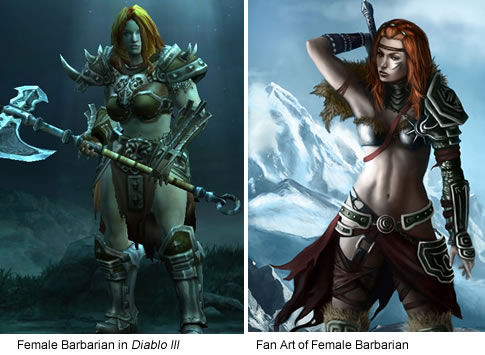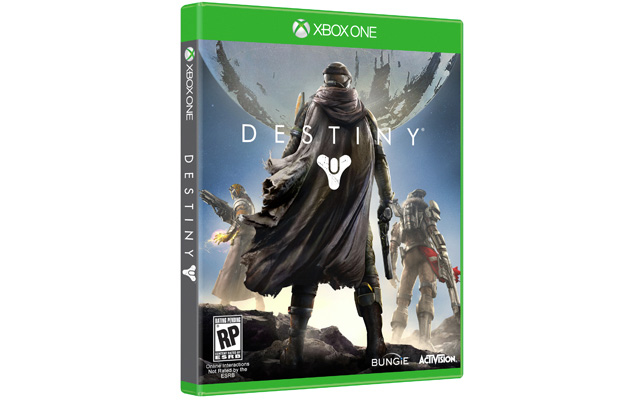I’ve been playing a lot of Diablo III lately, and not just out of guilt from pre-ordering it when it first came out and never really getting into it. For many reasons that I won’t bore you with here, I chose to explore it as one of three primary case studies for my dissertation research. And the first step of my research is to play the games – and not just play them but really play them.
I’m “supposed” to be playing Diablo III to study its effectiveness (or not) of instructional design. My goal is to look at how well it teaches its players how to learn certain aspects of the game, and that’s just great… except for one thing.
I. can’t. get. past. the. characters.
As in: the lack of character choice within the identity creation process of Diablo III (if you call choosing a gender, a class, and name a “process”) nearly ruins the game. When creating a character, you are only allowed to choose from the following options: 1) male or female; 2) Barbarian, Demon Hunter, Monk, Witch Doctor, or Wizard; 3) name. That’s it. If you and a friend are playing co-op and you both want to be female Monks, well guess what? You will both look exactly the same, down to the hair color and boob size.
Suddenly I remember why I hadn’t gotten into this game long ago.
I know that this is a topic that is often discussed at NYMG: that many of us prefer to play female characters when possible for a wide range of reasons (e.g., identity, immersion, exploration, narrative). And, like many other female gamers, when I start up a new game I will almost always (at least initially) pick the female option (and, sadly, there is often only one. Shall I get started on Borderlands 2? Nah, let’s save that for later), not just because I identify as female in real life and enjoy living vicariously through my characters online, but also because I visit virtual worlds not just to observe but to participate. And for me, playing male characters always pulls me out of the narrative because I can’t “see myself” within those aesthetics. I understand that not all gamers feel that way, but identity creation is a huge part of why I love MMOs (and a primary contributing factor to my altoholism, ahem), and so I feel that developers are making a big mistake in ignoring players who enjoy customizing their toons, MMO or not. And let me be clear: I’m not asking for all RPGs to include a multitude of options for toon creation, but at least provide enough to make us feel that we’re not just loading a template on the screen. I mean, hey, Blizzard, what about at least letting us change the hair color? Hair style? Body type? Dare I say: race?
 Speaking of race, don’t even get me started on the racial issues inherent throughout Diablo III. 80% of your character options are white or close to it (the Barbarian, Demon Hunter, and Monk classes are clearly white while the ambiguous Wizard class could be seen as either white or Asian). The Witch Doctor is the only African-American option and the character’s face is often obscured behind a tribal mask. Furthermore, everything about the Witch Doctor class—from the fighting style (e.g., shooting poison darts) to the voice acting (a cringe-worthy, over-caricaturized African accent)—is insulting to anyone who is even remotely paying attention. And you know something? From the developer who created World of Warcraft, one of the most successful MMOs of all time (and who, sadly, often comes under fire for rampant sexist and racist issues within that game), they should probably know better. Or maybe I just shouldn’t be surprised.
Speaking of race, don’t even get me started on the racial issues inherent throughout Diablo III. 80% of your character options are white or close to it (the Barbarian, Demon Hunter, and Monk classes are clearly white while the ambiguous Wizard class could be seen as either white or Asian). The Witch Doctor is the only African-American option and the character’s face is often obscured behind a tribal mask. Furthermore, everything about the Witch Doctor class—from the fighting style (e.g., shooting poison darts) to the voice acting (a cringe-worthy, over-caricaturized African accent)—is insulting to anyone who is even remotely paying attention. And you know something? From the developer who created World of Warcraft, one of the most successful MMOs of all time (and who, sadly, often comes under fire for rampant sexist and racist issues within that game), they should probably know better. Or maybe I just shouldn’t be surprised.
But anyway, let me tell you why all of this is a problem for a player like myself: We enjoy becoming immersed in a game, watching our characters fight and grow and earn (and often make) new gear and money (and even friends). We love the visual excitement of a worthy battle, the rush of earning that tough achieve. But if we can’t customize our characters to make them feel like an extension of us somehow, even a little bit, then the magic is lost. Instead of playing within the game, we are suddenly playing outside of the game, and that’s when things stop being fun.
The first character I leveled all the way in Diablo III was a Barbarian. I can’t tell you her name (not because I don’t want to but because I can’t remember it; that’s how little I connected with her in-game), but I can tell you that she had a terrible Norse accent and had an enormous frame compared to other classes in the game. I can tell you this because I played the game co-op with a friend who chose to play a male wizard, and he remarked that he would frequently lose track of whose character was whose because mine was so much bigger than his.
Um, thanks?
But I chose the female Barbarian because I love to play warrior classes; I enjoy getting right into the middle of the action and kicking ass without worrying about dying 17 million times. What I didn’t enjoy was being forced to play an insensitive oaf who was often depicted in the game (through various narrative forms) as the stereotypical brawn over brains. I should say: I loved that she was a fuller-figured female character; what I didn’t love was that she, of course, also had to wear just as skimpy of outfits as all the other women. (And in fan art, by the way, she is often depicted as a slender, buxom bad-ass. Shocker.)
But what if I wanted to play a strong, smart, brunette, female warrior, huh? Huh? HUH?! Apparently we can all laugh ourselves silly over that one, because it ain’t gonna happen.
Putting personal opinions about aesthetics and identity aside for a moment, it concerns me how widespread these gender and racial stereotypes have become in popular games. Diablo III has sold 2.55 million copies in North America and nearly double that number worldwide. (It is ranked #7 in all-time RPG sales behind The Elder Scrolls V: Skyrim, Fable III, Mass Effect 3, Borderlands 2, Mass Effect 2, and Dragon Age: Origins.) So when so many gamers are playing it, and few are talking about these cultural concerns, it worries me that we are just continuing to blindly accept these racial and gender stereotypes as if we’re all cool with it. And I, for one, am definitely not cool with it. What I’m saying is that this issue goes beyond my personal preference to customize and identify with my character; this inability to see beyond gender, racial, and even game-class stereotypes is damaging to the entire RPG genre and video games in general.
Yet, we can all talk about Blizzard’s problematic gender inequality or apparent racism all we want, but the fact remains that fans of RPGs and MMOs come back to Blizzard’s games again and again and again. We keep giving them our money—and lots of it. I have to admit that I’m guilty as charged; even as certain elements of the game make me cringe, I still often come back for more. But why? Is it because we’re ignoring these issues or is it because we don’t have many solid alternatives? I’ll likely consider this more in-depth in future posts but for now I’ll just throw out a guess that it’s mostly the latter. But is that a good excuse? I think this is the type of struggle that many gamers battle, especially those of us at NYMG. Because once you start seeing the issues (racial, gender, and otherwise) you can’t turn it off—but you also can’t turn off your love of games. And I don’t know about you, but I don’t exactly have the skillset (or, frankly, the desire) to go out and code my idea of a perfect MMORPG.
Don’t get me wrong. I understand that there are certain limitations to the amount of skins that a game can reasonably code without it getting out of hand. I understand that even the most minute of changes can be an incredible undertaking when it comes to coding the back end of a game. However, Torchlight II, a roguelike title quite similar to Diablo III in gameplay and released only four months after it, manages to allow gamers to change gender, skin tone, face, hair color and hair style (meaning: it is theoretically possible to allow for small customizations). And even those small changes can make a big difference for gamers who connect with their avis. What bothers me the most, then, is not only the fact that you can’t customize your avi within Diablo III but also: why isn’t Blizzard thinking about it? It’s as if they don’t understand (care?) that this stuff matters.
An RPG is, after all, a role-playing game, and so I don’t think it’s unreasonable to expect a certain level of identity customization within the genre. I play RPGs because I want to connect with my characters—from control over their hair color to choice about their names. Yes, I may put too much stock on the aesthetics of a game, but playing with identity and various roles within a virtual world is part of what makes me enjoy it. The point is that I want options to create—and to experience a game through—a character that I can identify with. And I don’t think that’s too much to ask from a genre that self-identifies as “role-playing.” And this, actually, may be part of the problem. Many games are now adopting the popular “RPG” moniker, even if their primary genre is something else. Prime examples are the Mass Effect and Borderlands titles; they call themselves RPGs but, some argue, are actually shooters with RPG elements. But playing a game with RPG elements is not the same thing as playing an RPG. How can I role play if only 1 of 4 standard class options are female (Borderlands 2)? How can I role play if 80% of my options are white and the others are racist (Diablo III)? How can I “role play” when I don’t have any choice in the character customization at all? (I’m looking at you, Deus Ex: Human Revolution.) Perhaps these games should stop calling themselves RPGs altogether. Or, at the very least, we should consider redefining RPG and/or establish a new sub-genre of RPG that better defines this type of popular crossover gameplay.
All of this is not to say that Diablo III isn’t fun; it is. As are many of these other games, actual RPG or not. In fact, especially for fans of roguelike RPGs, Diablo III is in many ways quite fantastic. The mechanics are smooth, the gameplay is paced well, and the graphics are stellar. Plus, the co-op options are fantastic, especially when we don’t see that very often anymore. But this one thing—this lack of character customization—can make all of these pluses null and void for a gamer like myself. After all, isn’t this supposed to be an RPG – as in: role playing game? How can I play a role if you so obviously limit my options?
And, seriously, Blizzard, this is getting really old.
In short, I think we need to start thinking more about the character options (or, more often, the lack thereof) for women in video games, especially within the RPG genre, which is supposed to offer above all else a rich role-playing experience. Developers: Stop thinking that you can throw “RPG” onto some cover art and make it a role-playing game. I’ll still play your game if it’s not an RPG and maybe then I won’t get so worked up when I expect to have control over my identity customization and I don’t. And gamers: Let’s start thinking more critically about our options and ways that we can vocalize our wishes for more realistic, inclusive avatars. Because as more and more people play within virtual worlds, I can only imagine that we will become more and more vocal about our desires to play something beyond the standardized white male stereotype.





